Tech Tip: One Handed Munters and Clove Hitches
Years ago a friend and I got to the first pitch belay ledge of Sheer Lunacy, where a party of two, a guy and his girlfriend, was in the process of bailing off Lunar Ecstasy. She was cute, and my buddy and I were both slovenly, smelly, road-tripping dirtbags, so we were understandably entranced by being in the presence of a real, live woman.
They were having an inordinate amount of trouble lowering their haul bag, and the girlfriend didn’t seem to know what to do, so I jumped in to help them out. Mind you, this was less out of good charity or trying to impress her and more out of the desire to get them out of our way so we could proceed unencumbered by the clusterf#$k they were in.
Snap, click, and zip, I reset a bunch of the junk they had going on and got their bag down and set for rappel. The girlfriend and I chatted while I quickly worked and then we were each on our way.
At the next belay my buddy exclaimed, “Dude, you so impressed her. What a cutie!” “Huh?” “After you left she fluttered her eyelashes with a whimsical look and said, ‘Your friend is really proficient with his rope skills.’” The comment drew laughs and became a running joke for the rest of the route and for years to come.
So in the hopes that you too can impress your friends, and maybe a cute girl (or guy), by tying one-handed munters and cloves, here’s a video tech tip to show how it’s done:
Tying One-Handed Munter and Clove Hitches from Glenwood Climbing Guides on Vimeo.
Why One Handed?
Efficient
Imagine you’re climbing a long pitch, but your lazy partner stopped short on the last pitch, meaning you’ll need to simul-climb to reach a ledge instead of a nasty hanging belay with the few pieces of gear remaining on your harness. But, the moment when you’re above your last piece and your partner is simuling can be extremely dangerous. Plus, he’s probably impatient to get to the top and enjoy beers, and might slip in a moment of inattention. After clipping your rope into one or more anchor pieces on the ledge, you can quickly throw on a munter belay with the one handed technique, and keep him moving up safely.
Secure
Perhaps you’re at a precarious stance on a Black Canyon multi-pitch, and you’ve just built your anchor. You’ve already clipped yourself into one or more of the pieces as you’ve built it, but your partner 200 feet below can’t hear you over the roar of the Gunnison River, so if you peel, you may go for a good ride. Throwing a quick, one-handed clove hitch into a piece can keep you secure and safe while you build the rest of the system.
Safe
Knowing when, where and how to make improvised anchors can be incredibly valuable and sometimes safer. Last summer, my friend Bobby and I were climbing Hallett Peak in Rocky Mountain National Park. A few pitches from the top the clouds started to let loose some rain drops and the thunder rumbled. Knowing it was quicker to head for the top, we raced up the last pitches. The jumbled stacks of blocks on top was going to make anchor building a time-consuming chore if I were to build a “proper multi-piece” anchor. Instead, I found a good seated belay position, plugged in a solid cam, clove hitched myself to the cam and after pulling up the rope, threw on a quick munter to quickly bring Bobby up. How much time did I save? A few minutes? Maybe more? At that point, it felt like a few minutes meant all the difference between safely scooting down the descent or getting fried by a lightning strike.
So, in short, whether you want to be more secure while simuling, more safe, more efficient, or just to impress someone, the one handed munter and clove are great skills to have!
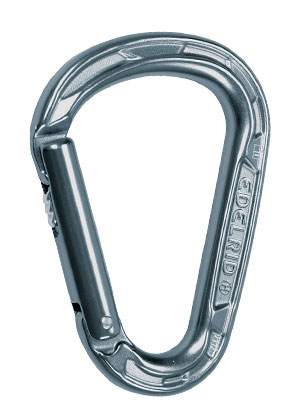 What’s that funky locker?
What’s that funky locker?
That locker with the weird and sketchy looking gate is the Edelrid HMS Strike Slider, a relatively new offering from the renowned German company. It’s a locking carabiner that is super easy to use. With just a little practice you can easily open the gate by sliding the button on the gate. After letting go, the gate snaps back in place and automatically locks. There is a small tooth that goes into the nose of the carabiner, locking the gate in place.
Does it work well? Yes and no. I love it for situations having a locker that can easily open and close, such as clove hitching into an anchor or throwing on a quick munter. But, occasionally the tooth inside the gate hangs on the carabiner’s nose and doesn’t close all the way and lock in place. Others have expressed concern about the ease at which it opens. Usually the reason you use a locker is to make sure the gate doesn’t come open. It may be a valid concern. When playing with the gate you can get it to open, although it may be improbably in a real climbing situation.
Hence, I may hesitate to use it in a toprope situation or where you can’t monitor the carabiner at all times. I have enjoyed using it for belaying, rappelling and tying munter and clove hitches. In those situations, it’s a great locking carabiner and a rope moves smoothly because of the rounded stock. It’s also a great locker to carry when you’re looking to shave some weight.
At $19.95 it’s a decent price for a highly featured locking carabiner and at 62 grams it’s one of the lighter, full-size lockers you’ll find. Personally, I give it a big two thumbs up and have enjoyed it thoroughly.
Mike Schneiter is the owner of Glenwood Climbing Guides.
2 Responses to Tech Tip: One Handed Munters and Clove Hitches
Bulldog Creek Dog Walk (IV WI 4+)
Hayden Carpenter and Tom Bohanon recently repeated an obscure ice climb on the south side of Mt Sopris. Given a brief mention in Jack Robert’s ice guide, Bulldog Creek Walk is described as being 100 meters of WI 4. What they found was seven pitches of ice in a remote setting that makes for one […]
Connect with Us








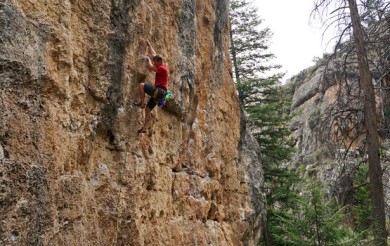
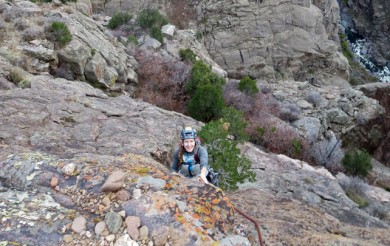
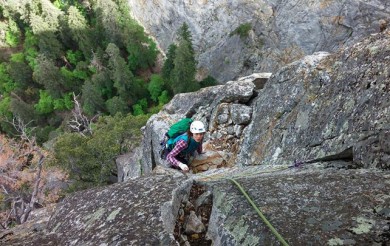
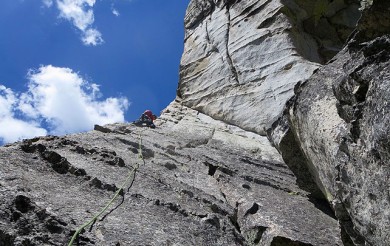



This video shows the worst way to set up anchor. He is ruining the anchor with the metal to metal contact. He should be running rope though instead of the carabiner. He is also relying on stitches on the sling rope.
Good Luck!
trololo isn’t that cute. 1. The alum of the carabiners will grove instead of the steel. 2. Are you saying you would girth hitch a sling or actually tie a cordalette into those rings? 3. Oh yeah stitches rated to 22kn are not to be trusted….